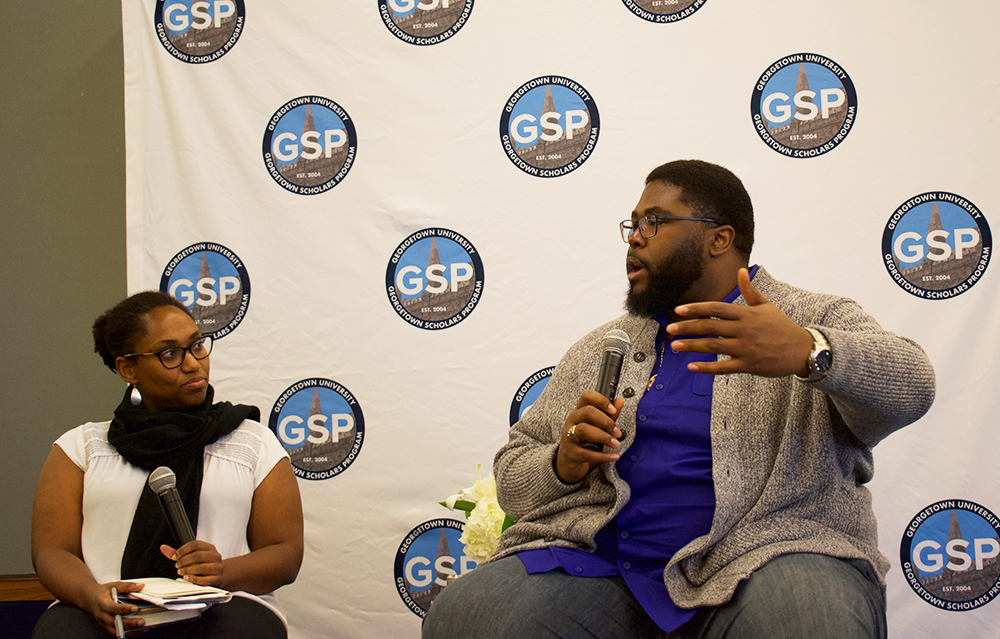While universities in the United States have made progress in admitting a more diverse student body, schools must better support low-income and first-generation students throughout their college experiences, assistant professor of education at the Harvard Graduate School of Education Anthony Jack said at an event Thursday.
The event, titled “A Conversation with Tony Jack,” was hosted by the Georgetown Scholars Program, a campus organization that provides support, advising, networking and mentoring to over 600 Georgetown undergraduates, most of whom are first-generation college students or come from low-income family backgrounds. At the event, Jack discussed his first book, “The Privileged Poor: How Elite Colleges Are Failing Disadvantaged Students.”

Despite the recent efforts of many selective universities to increase the diversity in their student bodies, the emphasis on admitting more low-income, first-generation students often does not translate into a greater effort to provide support to these students, according to Jack.
“You can diversify a campus all you want,” Jack said. “We all know that just because you gain access doesn’t mean that you have access to the resources of that place.”
Universities often only focus on improving overall admissions and graduation rates of lower-income students without paying attention to issues these students may be facing on a day-to-day basis, Jack said.
“We only focus on who gets in and who gets out,” Jack said. “We never focus on the experience throughout college life, those overlooked moments between convocation and commencement.”
In his book, Jack reflects on his own experience transitioning from a low-income, public school background to a selective, private high school and university. Based on his observations, he distinguishes between two different groups within the low-income college student population: the “doubly disadvantaged,” low-income students coming from public schools, and the “privileged poor,” those who attended private or boarding schools.
A large majority of the low-income students whom universities admit are part of the privileged poor, according to Jack. This tendency prevents universities from making practical progress in increasing opportunities in higher education for low-income college students, Jack said.
“If you’re getting such a significant number of your lower-income students who also were taught by the Harkness method, who were taught by Ph.D.s in high school, who studied abroad in high school, you won’t feel the pressure to do as much work to incorporate, include them into the conversation, because you’re so used to people already doing that themselves,” Jack said.
The Harkness method is a learning method primarily practiced in boarding schools involving students seated at a large, oval table to encourage free discussion with minimal teacher intervention.
While the doubly disadvantaged and the privileged poor both experience the financial burden inherent to higher education, the privileged poor come to colleges better equipped because of their earlier exposure to the kinds of practices expected of college students, according to Jack.
“When we talk about social class in higher education, it’s always one of two things: tuition costs and how much money you have or social class in the form of cultural capital, like do you feel comfortable having certain conversations about where you can go for vacation and other things like that,” Jack said.
Of the top 12 high schools that sent the most students to Georgetown in 2014, eight were boarding schools, and two were private schools. More recently, Georgetown ranked 12th on a 2017 New York Times study detailing income inequality at universities, with more students coming from the top 1%, defined as families with an annual income higher than $630,000, than students coming from the bottom 60%, defined as having an income less than $65,000.
Universities must work towards gaining a greater understanding of the diverse backgrounds and hardships of low-income college students, according to Jack.
“That ignorance is hard to navigate because the people who often control the purse strings of the university have the least amount of contact with students and have the least knowledge of the kind of environment, home situations and experiences en route to college of what our students have,” Jack said. “And until we change that, until we actually understand the true profile of our student body, we will continue to fail our students in ways that we actually can help them.”




















